We visit the superb British Commercial Vehicle Museum
Posted by Chris Graham on 16th May 2024
Mike Neale reports on a very enjoyable visit to the famous British Commercial Vehicle Museum at Leyland, in Lancashire.

British Commercial Vehicle Museum: Stop me and buy one! – Morris MCV ice cream van.
The British Commercial Vehicle Museum in Leyland, Lancashire is considered by many to be the UK’s premier transport museum dedicated to commercial vehicles. It occupies one of the few surviving parts of the original Leyland Trucks factory, built in the 1930s and was previously used as the Customer Inspection Department. It’s been a museum since 1983, with a refurbishment carried out in 2019 thanks to Heritage Lottery funding and the generous support of sponsors. British commercial vehicles from the horse-drawn era up to 21st Century hybrid and electric trucks are on display, not just those made by Leyland Motors group companies.
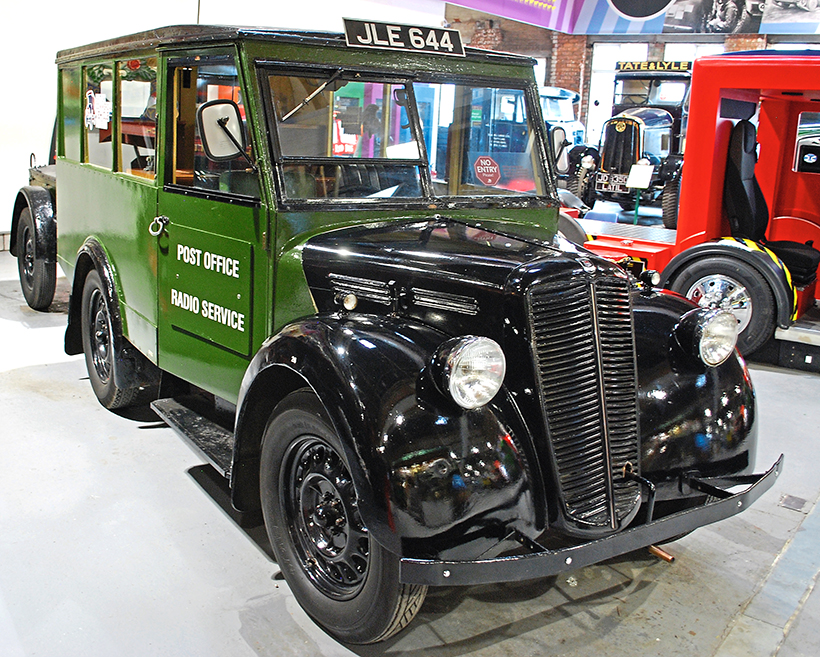
Post Office Radio Service Morris Y-Type van dates from 1949.
At the entrance I was greeted by a very cute cream and red 1952 Morris Cowley MCV ice cream van in the livery of local ice cream firm Frederick’s, who are still trading today. Built new as an ice cream van, rather than a later conversion, it was based on the van version of the Morris Oxford MO, with a 1,476cc four-cylinder sidevalve petrol engine. Its first owner, Johnny Orsi, used it from 1952-’80, with Tony Frederici of Frederick’s Dairies then buying the van, and later donating it to the museum.
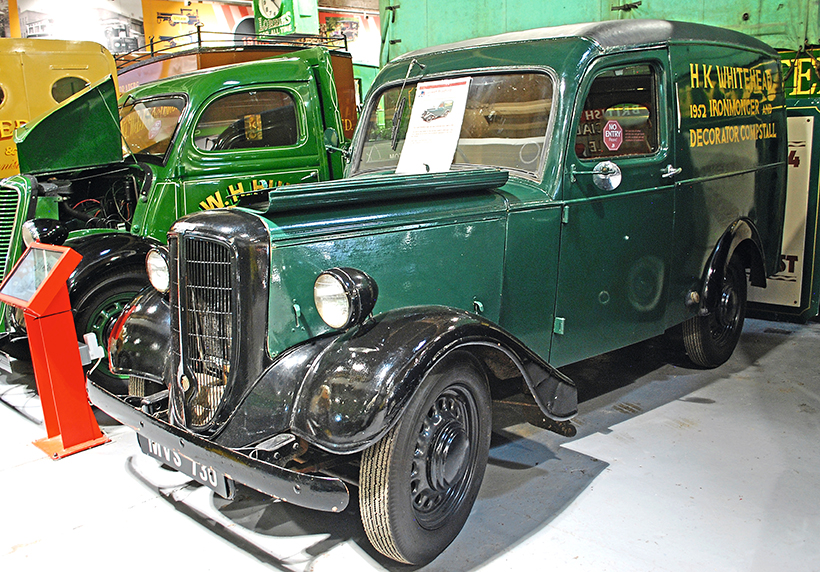
The Bradford van provided economical transport for many small businesses.
A 1949 Morris Y-Type 10cwt Post Office Radio Service Van was one of a batch of 165 vans with a coachbuilt body by OG Lywood to GPO Specifications, a squarer design than the normal production van. They were fitted out as mobile offices and contained equipment to detect unauthorised radio transmissions and interference. They had a 1,547cc four-cylinder petrol engine.
Another small light commercial was the 1949 Jowett Bradford van, fitted with the distinctive sounding Flat-twin 1,005cc engine. Bodies were produced by Briggs in their Doncaster plant, 30 miles from Jowett’s factory in Idle. It was essentially a revamp of the prewar Jowett 8hp van, intended as a short-term model until a newer design could be developed, although the latter was sadly stillborn due to Jowett’s closure in 1953. In production from 1946 to 1953, over 38,000 Bradfords were built.
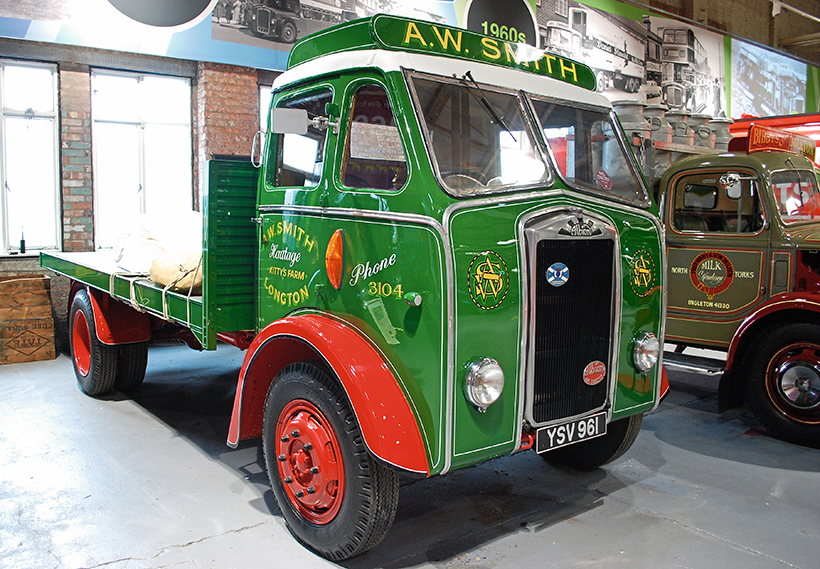
1960 Albion Claymore flat lorry.
An eye-catching Leyland lorry was the 1955 Octopus petrol tanker in green, red & black Shell-BP livery with the all-steel, forward control ‘mouthorgan grille’ cab design introduced in 1954, a full-size Corgi model! This one was fitted with a 150hp Leyland O.680 diesel engine. The first Octopus lorry appeared in 1935, and (pub quiz fact) while Leyland’s ‘zoo’ model name policy is well-known, the Octopus was the only Leyland vehicle named after a marine animal.
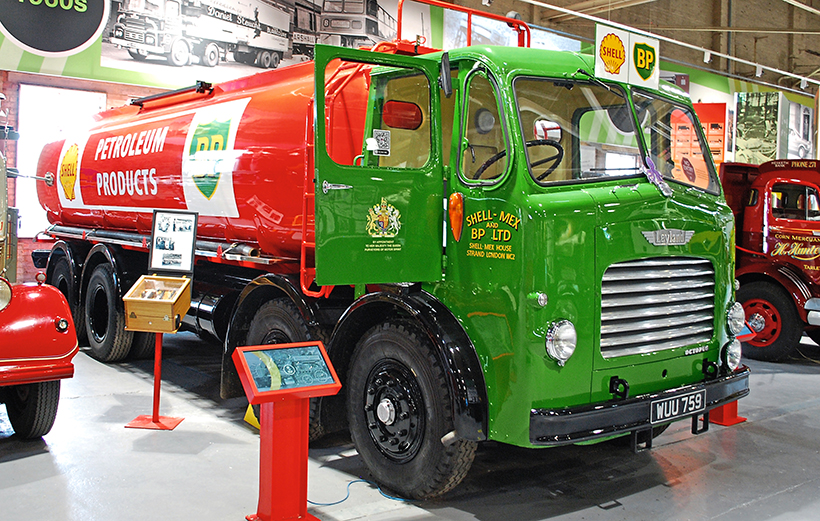
A splendidly turned-out Leyland Octopus Shell-BP tanker.
Another eight-wheeler was the Southall-built AEC Mammoth Major MkIII 8×2 flat lorry, model type 3871, in yellow and blue Michelin livery, dating from 1954. It had an AEC 9.6-litre engine developing 125hp. There was, unsurprisingly, a Michelin man perched in a slightly uncomfortable looking position on the roofboard. The Mk.III was in production from 1948 to 1960.
Dating from 1960, although looking rather older, was an Albion Claymore four-wheel flat. This had a four-cylinder 251cu.in. Albion diesel engine. It was supplied new to George Robbie Contractors Ltd. of Dundee and used to carry hessian from the local jute mills. Albion was based in Scotstoun near Glasgow, becoming part of the Leyland Motors Group in 1951.
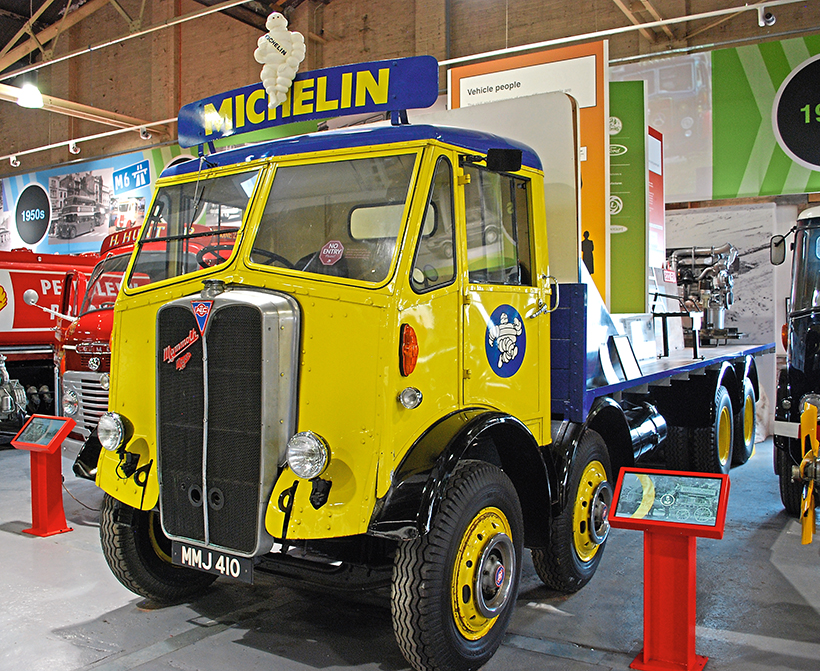
Michelin-liveried AEC Mammoth Major Mk.III was actually new to Marston Valley Brickworks, near Bedford.
One of the larger vehicles in the museum was the 1976-built Scammell Contractor, fitted with a Cummins NTC 335 14-litre, six-cylinder diesel engine with a power output of 335hp. The vehicle’s gross train weight was 240 tons. Named ‘Intruder,’ it was new to Wrekin Roadways, until being sold to Abnormal Load Engineering (ALE) in 1983, a heavy-haulage contractor specialising in transporting transformers and generator components for power stations. They used it across the world until 2002, its last job being in the Bahamas. ALE restored it to full working order and original specifications in 2017.
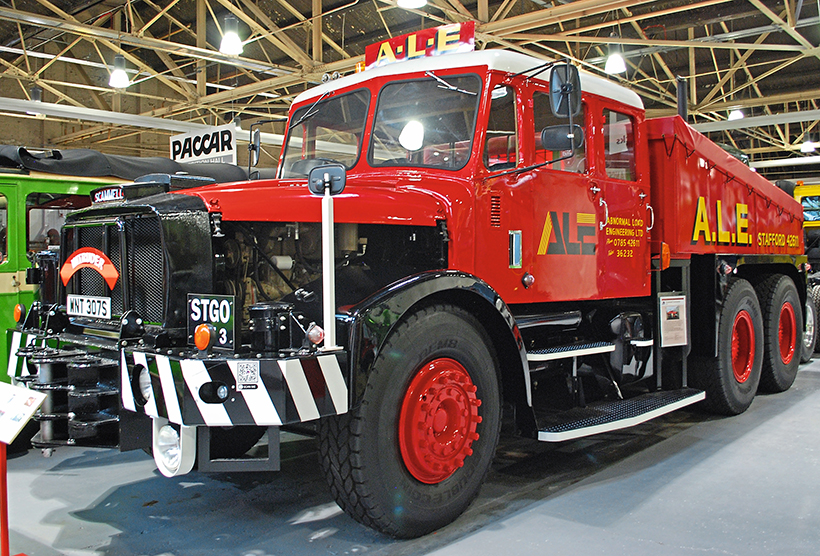
The imposing Scammell Contractor.
An example of an early Bedford lorry was the 1932 WLG dropside. The first Bedford-badged commercials appeared in April 1931, the WLG being a two-tonner with a 157in wheelbase. They were based upon the earlier Chevrolet designs that had been built in Luton since 1929 by General Motors, but underneath they had various mechanical differences. They had a six-cylinder, 3.2-litre OHV petrol engine. This one was used by a haulage contractor in Lincolnshire but has been restored in the livery of a farmer in Lancashire.
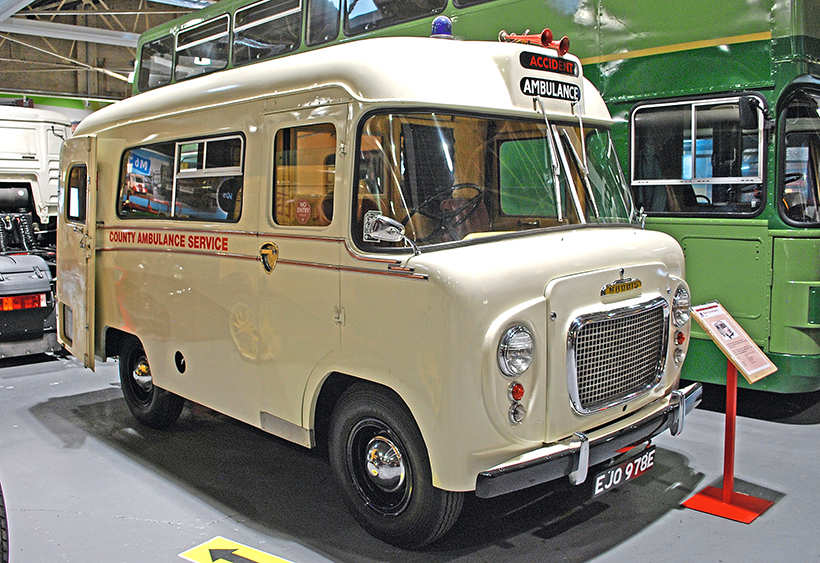
Morris LD Wadham Ambulance that served the MG and Morris factories.
Another Bedford, and one that many people in Britain would instantly recognise, even non-enthusiasts, was the 1953 Bedford RLHZ 4×4 ‘Green Goddess’ fire engine, if only from when they reappeared on the streets during fire brigade strikes as recently as 2002. The engine was a six-cylinder, 4.9-litre petrol unit. They were fitted with 300-gallon water tanks and Sigmund FN4 pumps capable of delivering 900 gallons per minute from lakes, rivers or canals. Ten different bodybuilders constructed them to a standard design. Their existence is due to the Cold War, with a nationwide fleet of these emergency pumps being commissioned by the government to cope with an emergency response in the event of a nuclear attack. The government sold them off in 2004.
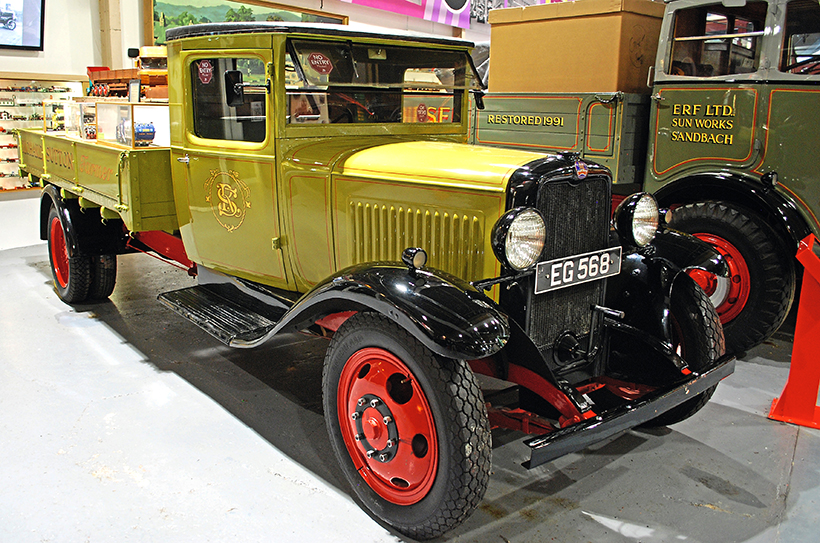
One of the first Bedford lorries, a 1932 WLG.
Another emergency vehicle on display was a 1967 Morris LD Ambulance, its fibreglass body built by Wadhams in Waterlooville, Hampshire, on the LDM30 1.5-ton van chassis. It had a 2.19-litre four-cylinder petrol engine and was initially the works ambulance at the MG car factory in Abingdon, and later at the Morris works in Cowley. After the Bedford J1 Lomas, the BMC Wadham was perhaps one of the most familiar ambulance designs of the 1960s.
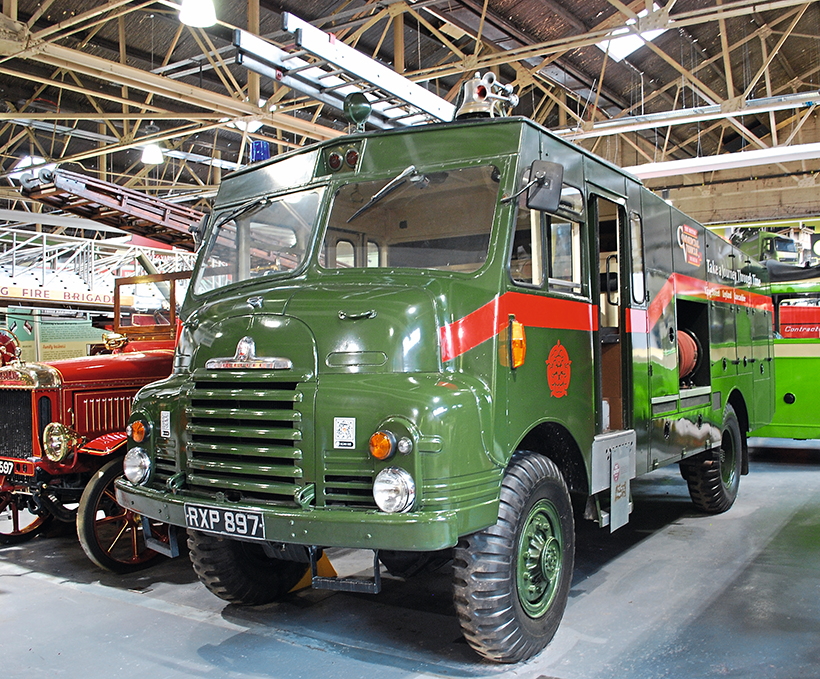
Cold War era Bedford RLHZ Green Goddess.
The museum is open Wednesdays to Sundays from 10am to 4.30pm, plus Bank Holiday Mondays. Admission is £10 (Children 4-16 £5, under 4s free, family tickets also available). See https://www.britishcommercialvehiclemuseum.com/. There is the Leyland Heritage café for food and refreshments, plus a gift shop, which at the time of my visit had a good selection of back issues of CV.
This feature comes from the latest issue of Classic & Vintage Commercials, and you can get a money-saving subscription to this magazine simply by clicking HERE
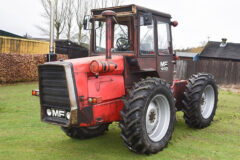
Previous Post
Giant MF 1200 spotted in the wilds of Shropshire!
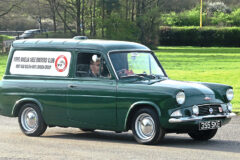
Next Post
A visit to the fantastic Heritage Transport Show!



